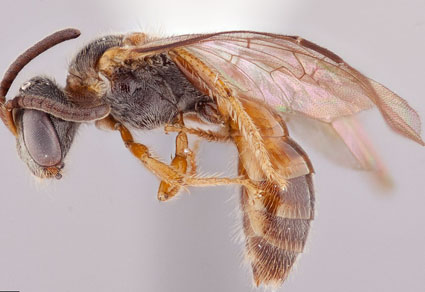Abstract
We diagnose, describe and illustrate three new species of Microsphecodes Eickwort and Stage, all from the nominate subgenus: M. peckorum Graham and Packer n. sp. from Venezuela, M. fernandoi Graham and Packer n. sp. from French Guiana, and M. septentrionalis Graham and Packer n. sp. from Guatemala. The latter extends the known range of the subgenus further north by approximately 500 km. We provide an updated, illustrated, key to the species of Microsphecodes s.str.
References
- Ascher, J.S. & Pickering, J. (2020) Discover life bee species guide and world checklist (Hymenoptera: Apoidea: Anthophila). Available from: http://www.discoverlife.org/mp/20q?guide =Apoidea_species&flags=HAS (accessed April 2023)
- Danforth, B.N. (1989) The evolution of hymenopteran wings: the importance of size. Journal of Zoology, 218, 247–276. https://doi.org/10.1111/j.1469-7998.1989.tb02536.x
- Eickwort, G.C. & Stage, G.I. (1972) A new subgenus of neotropical Sphecodes [sic] cleptoparasitic upon Dialictus [sic] (Hymenoptera: Halictidae, Halictinae). Journal of the Kansas Entomological Society, 45, 500–515.
- Engel, M.S. (2013) A new species of Microsphecodes from Peru, with notes on the classification of the genus (Hymenoptera: Halictidae). Journal of Melittology, 24, 1–9. https://doi.org/10.17161/jom.v0i1.4433
- Freitas, F.V. Santos Júnior, J.E. Santos, F.R. & Silveira, F.A. (2018) Species delimitation and sex associations in the bee genus Thygater, with the aid of molecular data, and the description of a new species. Apidologie, 49, 484–496. https://doi.org/10.1007/s13592-018-0576-0
- Gonçalves, R.B. (2021) A revised genus-level classification for the Neotropical groups of the cleptoparasitic bee tribe Sphecodini Schenck (Hymenoptera, Apidae, Halictinae). Revista Brasileira de Entomologia, 65 (1), e20200094. https://doi.org/10.1590/1806-9665-rbent-2020-0094
- Habermannová, A., Bogusch, P. & Straka, J. (2013) Flexible host choice and common host switches in the evolution of generalist and specialist cuckoo bees (Anthophila: Sphecodes). PLosONE, 8 (5), e64537. https://doi.org/10.1371/journal.pone.0064537
- Harris, R.A. (1979) A glossary of surface sculpturing. Occasional Papers in Entomology, Department of Food and Agriculture, Division of Plant Industry, 28, 1–36.
- Mahlmann, T. & Engel, M.S. (2023) First occurrence of the cleptoparasitic bee genus Microsphecodes from Amazonian Brazil (Hymenoptera: Halictidae). Entomologists’s Monthly Magazine, 159, 105–109. https://doi.org/10.31184/M00138908.1592.4194
- Michener, C.D. (1978) The parasitic groups of Halictidae (Hymenoptera, Apoidea). University of Kansas Science Bulletin, 51, 291–339. https://doi.org/10.5962/bhl.part.24961
- Michener, C.D. (1979) New and little-known Halictine bees from Colombia (Hymenoptera: Halictidae). Journal of the Kansas Entomological Society, 52, 180–208.
- Michener, C.D. (2002) The bee genus Chilicola in the tropical Andes, with observations on nesting biology and a phylogenetic analysis of the subgenera (Hymenoptera: Colletidae, Xeromelissinae). Scientific Papers Natural History Museum University of Kansas, 26, 1–47. https://doi.org/10.5962/bhl.title.8449
- Michener, C.D. (2007) The Bees of the World, 2nd Edition. John Hopkins University Press, Baltimore, Maryland. xiv + [i] + 953 pp., 20 pls.
- Mir Sharifi, N., Graham, L. & Packer, L. (2019) Fifteen new species of Liphanthus Reed (Hymenoptera: Andrenidae) with two submarginal cells. Zootaxa, 4645 (1), 1–80. https://doi.org/10.11646/zootaxa.4645.1.1
- Packer, L. (2016) Two new species of Epeolini (Hymenoptera: Apoidea: Apidae) from Chile with the first record of Triepeolus from the country and a key to Chilean Doeringiella species. Journal of Melittology, 64, 1–11. https://doi.org/10.17161/jom.v0i64.5775
- Packer, L. & Graham, L. (2020) Four new species of Isepeolini (Hymenoptera; Apidae) from northern Chile. BMC Zoology, 5 (3). https://doi.org/10.1186/s40850-020-00052-8
- Sakagami, S.F. & Moure, J.S. (1962) Sphecodes russeiclypeatus, n. sp., obtido de um ninho de Dialictus (Chloralictus) seabrai (Moure, 1956). Boletim da Universidad do Paraná Zoologia, 18, 1–6.
- Sheffield, C.S., Pindar, A., Packer, L. & Kevan, P.G. (2013) The potential of cleptoparasitic bees as indicator taxa for assessing bee communities. Apidologie, 44, 501–510. https://doi.org/10.1007/s13592-013-0200-2
- Shorthouse, D.P. (2010) SimpleMappr, an online tool to produce publication-quality point maps. Available from: https://www.simplemappr.net/ (accessed 22 Sep 2019)


